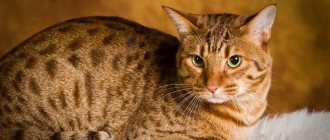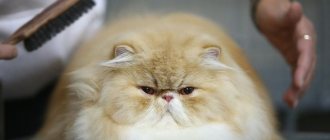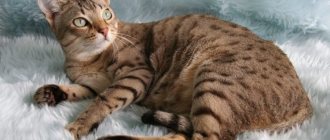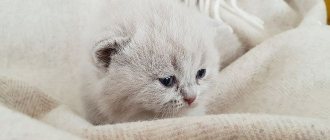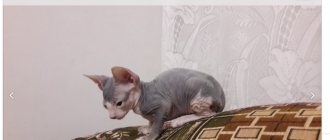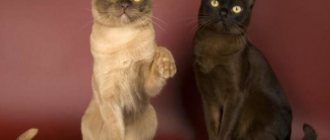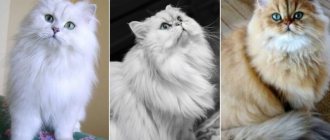All representatives of the cat family can be called cute and charming in their own way. People admire their pets no matter what they look like, even if some of them don't have a luxurious, fluffy coat. Sphynx cats are amazing and unusual creatures. When looking at them, an ignorant person gets the impression that nature played a joke on these animals by depriving them of hair. In fact, Sphynxes are an independent breed, bred at the end of the twentieth century. These cute hairless creatures are very popular among cat lovers.
How does the Canadian Sphynx differ from the Don Sphynx? This question cannot be answered simply. Having a hairless friend at home is very fashionable today. In addition, it is extremely convenient: you do not need to constantly clean the apartment and collect scraps of fluff. At first glance, it may seem that all hairless cats are equally alike. Some call them terrible monsters, others admire their natural irresistibility. Meanwhile, even some experts do not always have an idea of how the Canadian Sphynx differs from the Don Sphynx. And these are two different breeds, although very similar in appearance. How can you learn to distinguish them? There are several characteristic signs.
Difference in origin
The Canadian Sphynx was bred approximately 50 years ago and immediately won the hearts of feline fans. This breed is not related to the Egyptian pyramids.
The history of the Sphynx began in the province of Ontario (1966), when an ordinary couple gave birth to a hairless kitten. Later, breeders from the USA joined the selection, and as a result of inbreeding, they managed to consolidate the differences in the breed characteristics of the new species.
Later (2006), Canadian Sphynxes, together with American Curls, were used to create the elf breed. These were completely “naked” cats with the shape of the ear, characteristic of the fairy-tale characters of the same name. The selection was successful, but has not yet received official development.
International felinological associations have recognized the standard of the Canadian Sphynx and allowed animals to participate in exhibitions and breeding.
The Don Sphynx is one of the few breeds bred in Russia. The beginning was made in Rostov-on-Don (1986), when the ordinary cat Varvara (owner Elena Kovaleva) began to lose hair on her back and head. The treatment did not bring positive results, Varvara continued to go bald.
In 1992-94. Irina Nemykina (the owner of one of Varvara’s kittens) decided to experiment with matings and offspring, and gradually achieved her goal. The daughter of a Rostov cat gave birth to children without fur. By 1996 there were already so many of them that it became possible to register a new breed.
Without the sustainable formation of differences that were inherited from the Canadian Sphynxes, this would have been impossible.
None of the people who had a hand in the formation of the Don Sphynx cat breed was a professional felinologist and had no idea about the rules of breeding, unlike the Canadian-American selection, where breeding was carried out by professionals.
The process of mating cats
In most cases, mating of Canadian Sphynxes lasts no more than half a minute. She is accompanied by rather loud cries of a cat and a strong purring of a cat. Just at this moment, an egg is released from the cat's ovaries. However, fertilization does not occur immediately, taking about a day. In some cases, one mating is not enough for pregnancy to occur, and therefore both partners must spend a few more days with each other.
The most favorable time for mating of the Canadian Sphynx is the third to fifth day of estrus. This is explained by the fact that this is precisely the period when females ovulate.
If you look closely at the behavior of the Canadian Sphynx, it will be very easy to understand when mating has completed. Indeed, immediately after the end of mating, the female begins to roll on the floor, turning over on her back, and she can do this for a fairly long period of time. As for the cat, after finishing mating he strives for privacy and begins to wash himself and lick his fur.
Different breed genetics
Getting to know the fascinating world of chromosomes, loci and genes that are responsible for the absence of hair will help you better study the differences between the Don and Canadian Sphynxes.
Canadian Sphynx
Since this cat breed was the first to appear, observations of it contain a greater amount of knowledge. The selection was carried out purposefully and took into account the rich experience accumulated by felinologists.
- Back in 1938 Frenchman Etienne Letard published a description with a list of differences between hairless kittens. True, they were not talking about Canadian (and especially Don) sphinxes, but about Siamese. The allelic gene from this work was precisely the reason for the appearance of the Canadian Sphynx.
- The "bald" mutation occurs due to the recessive hr gene. In the animal's genetic map, it is responsible for the absence of integument.
- Canadian cats cannot be crossed with other breeds. The Devon Rex took part in its breeding, and hr still carries information about the difference in their genome.
Objectively, these cats are not completely hairless. They have residual growth on their tail, paws and head.
Cat – Canadian Sphynx
Don Sphynx
We can say that this breed is the result of a happy coincidence. If domestic lovers did not know about the existence of the bald Canadian Sphynx, they would hardly have decided on such a dizzying genetic adventure.
Moreover, the ancestor of all domestic hairless cats, Varvara, did not impress professional felinologists.
- The cause of baldness was a spontaneous mutation caused by circumstances that were never established.
- Hair loss is caused by the presence of a dominant allele (a form of the gene responsible for the development of certain traits) Hbl. In our example we are talking about the absence of vegetation on the skin.
- The difference between the Don Sphynx and the Canadian one is that it can be of 3 types:
- completely naked (rubber);
- flock (initially the animal is covered with sparse fluff, which gradually disappears);
- brush
The latter has dense fur and curly mustaches. With age, they may disappear or remain for life, adding to the list of differences from the Canadian cat breed.
Brush cats have no show value, but when crossed they produce high-quality “rubber” offspring and are therefore interesting for breeding.
Important: the difference between the Don and the Canadian Sphynx is the reason for the loss of hair. In the Russian breed, a dominant gene is responsible for this anomaly, while in an overseas cat it is recessive (suppressed).
Cat - Don Sphynx
Care and maintenance
Animals can live in ordinary apartments, but they wouldn’t mind living in a country house. However, place of residence is not as important for them as communication with a person. This breed is not attached to the house, but to the owner. Temperature conditions, proper nutrition, skin care, claws and eyes are also important for her. Nothing unusual. However, this is a special breed - the Canadian Sphynx. Care and maintenance are complicated by special skin care. Pets are bathed more often than other breeds, and they need clothes.
Skin hygiene
The Sphynx cat is genetically deprived of natural clothing - fur. In most felines, it not only takes part in regulating temperature, but also absorbs sweat and secretions secreted by the skin. This is not the case with hairless pets. They also have discharge, but it does not settle on the fur. From time to time, sweat and a brown fatty film appears on the cat’s skin, which needs to be washed off.
Fatty lubrication is the mirror of health for the Sphinx. The fattier the food, the faster it gets dirty. The rate of skin contamination is also affected by the gender of the pet. Cats get dirty faster than cats. And uncastrated animals are more likely than castrated ones. If there is too much skin discharge, this indicates problems with nutrition or the presence of any diseases.
How to bathe a Sphynx?
Pets are bathed with special shampoo. It can be replaced with a baby wash with a pH of 5.5. They do this at intervals ranging from several times a week to once a month. The procedure is stressful for the animal. Therefore, some breeders recommend simply wiping the animal's skin with a damp towel or napkin. But it's not that easy. Bathing is an easier way to take care of your skin.
Remember that the temperature of an animal is higher than the temperature of the human body. Therefore, the water should be warmer than usual. The optimal water temperature is about 40 degrees. Its level in the bathroom should reach the animal’s chest, but not higher. Otherwise, the purr may get scared.
When the font is ready, follow these instructions:
- slowly place the animal in the bathtub;
- let your pet get used to the water;
- only after this, soap all areas of the body with a soft sponge;
- there is no need to wash the face;
- you need to make sure that foam and water do not get into your ears;
- rinse the foam thoroughly with clean warm water;
- There should be no shampoo left on the skin, otherwise skin irritations will appear;
- blot moisture with a paper towel;
- do not release the animal immediately after bathing, wrap it in a dry cloth;
- When the cat is completely dry, you can free her from the diaper.
Do not use a hairdryer to dry your skin. Firstly, your pet will not like its sound, and secondly, a strong flow of warm air will dry out delicate skin and can lead to the appearance of dermatitis.
Not all Canadians like to swim. During water procedures, some behave scared, but quietly, others try to escape. And then swimming turns into a battlefield. If your cat is afraid of bathing, try creating plenty of foam on the surface of the water. This will help him see the boundary between water and air. Cats, as a rule, do not see it in clean water. And this scares them.
Claw hygiene
Most Canadians are exclusively domestic cats. Even if they have a scratching post in their arsenal, they still do not have the ability to naturally grind down their claws. Therefore they need to be trimmed. This is done carefully so as not to catch the “live” area of the claw.
Only the outer transparent part of the claw is cut off. To do this, use special tweezers or a guillotine. The sensitive part appears darker. Vessels and nerve endings are located there. It is easy to distinguish, but if in doubt, it is better to cut less than necessary rather than touch a sensitive area. Because such injuries are very painful and take a long time to heal.
Ear care
The ears of cats of this breed are its pride. They form the overall appearance of a Canadian and look impressive. But since the body temperature of animals is quite high, and metabolism occurs at an accelerated pace, brown secretion quickly accumulates in these large ears. This happens faster than in other breeds of purrs, therefore, the ears need to be cleaned more often. As a rule, the procedure is repeated every week.
For these purposes, cotton swabs are used. The best option is sticks for newborns: they are thicker and more convenient to use. You can use a special ear product. But there is no need to penetrate deep into the ear. Only the visible part can be cleaned. With deep penetration, the risk of damaging the ear and developing otitis greatly increases.
Eye care
Canadians have beautiful eyes, but they do not have a natural barrier - eyelashes. This causes impurities to accumulate in the eyes. They need to be removed with a soft, lint-free cloth. The fabric can be moistened in a special product or in chamomile decoction. It can be replaced with regular tea. Brown and clear discharge is considered normal. But green, yellow and white discharge indicates a problem. This could be an infection or injury.
Dental hygiene
There are special foods that, when eaten, help prevent plaque. But it is not always possible to avoid unpleasant odor and inflammation of the gums. To prevent this from happening, brush your teeth with a soft brush and a special product. The baby is accustomed to the procedure from childhood.
Differences in appearance: a portrait of two breeds
A rounded head, a distinct border line from the cheekbones to the muzzle, a flat surface of the skull in front of the ears and a strong chin running perpendicularly from the upper lip are the features inherent in the Sphynx.
You also need to add to the portrait expressive eyes (obliquely set, wide in the middle and tapering towards the corners), a long “rat” tail, folded skin covered with delicate fluff, a flexible body, strong legs and disproportionately large erect ears.
After such a portrait, you no longer have to think about the length of the body, the area of the croup and the folds on the neck. In front of you is definitely a Canadian Sphynx.
Any colors are allowed: plain, with spots and marks. The only difference that disqualifies show animals is the zonality of hair coloring.
The Don cat has a wedge-shaped head, with a sloping forehead and clearly defined cheekbones. Longitudinal folds come from behind the ear line and diverge to the sides above the eyebrows.
The eyes are almond-shaped, obliquely set. The ears are large, with a rounded contour.
The folds are located only on the head, armpits, groin and neck. In winter, a thin fluff may appear on the body of the Don Sphynx, but by the age of 2 years an adult animal should be completely naked, without hair.
Any colors are allowed - color is not a significant distinguishing feature.
On the left is the Don Sphynx, on the right is the Canadian
Important: Don Sphynxes are hardy and have stable immunity to diseases. Their Canadian counterparts have a low pain threshold and poorer health.
Health, tendency to disease
This is a healthy cat breed. However, pets may experience:
- breast hypertrophy;
- fibroadenoma;
- shortening of the lower jaw;
- congenital entropion of the eyelids;
- obesity;
- acne
Sphynxes are also prone to specific dermatoses. But this is not always a pathology. For example, the seasonal appearance of red patterns on the skin, acne, or changes in skin color do not always require treatment. But only a veterinarian can find out.
Differences in character: a family for a cat or vice versa
Any appearance fades into the background when it comes to the behavior and attitude of animals towards people. After all, some cats are capable of demonstrating quite predatory habits, even aggression. In families with children, such an animal has nothing to do.
Fortunately, Sphynxes belong to the group of quite friendly representatives of the cat family, although Dons and Canadians have differences here too.
The Don Sphynx is friendly towards all family members and pets. The Sphynx kitten will spin under your feet, look into your eyes and wait for any reason to play together. Representatives of this breed are not afraid of new people and react calmly to large, noisy companies.
Canadians are less sociable; they choose their owner independently and prefer to spend time only with him. The head of the family does not necessarily become such an authority.
They treat other cats and dogs calmly - they will put up with such proximity, but will try to keep their distance from the group.
When trying to reduce the communication distance that is comfortable for him, the animal may show aggression. Even the exhibition standards of these cats provide for removal from the ring if the competitor does not give in to the hands of the referee and shows emotional incontinence.
Puberty
It occurs much earlier than the physiological one - at 6-8 months. In males this happens later. It is recommended to start mating with a cat from the 3rd heat. The time of puberty and hormonal storms is marked by changes in the behavior and character of both sexes. The cat becomes affectionate, pliable or sharply aggressive, unapproachable. He attracts attention in different ways, rubs against objects, walks slowly and purrs, trembles, and moves his paws. The male begins to show belligerence, becomes demanding, and leaves marks.
Which Sphinx to choose
A detailed description of the differences between the Canadian and Don Sphynx is presented in the table.
| Canadian Sphynx | Don Sphynx | |
| History of the breed | Originally from Ontario, breeding began in 1966. | Originally from Russia, the first kittens were born in 1992 in Rostov-on-Don |
| Genetic differences | The recessive hr gene is responsible for the Canadian cat's hairlessness. If crossed incorrectly, it can be suppressed by dominant genes. Then the offspring will not inherit hypotrichosis (thinning hair). | The hairless trait of the Don Sphynx is based on the dominant Hbl allele, formed due to a natural mutation. It consistently transmits parental characteristics to subsequent generations. |
| Kittens | They are born with residual hair on their paws, tail and head, which lasts a lifetime. In practice, there are almost no completely “naked” Canadian Sphynxes. | A water litter can produce kittens of several varieties: rubber (without hair), brushes and flocks. The last two are distinguished by the presence of hairs on the body, but by the age of 2 they “undress”. |
| Constitution | The cat is medium in size, with a muscular body and a well-developed chest. The hind legs are slightly longer than the front legs, which causes the back to rise up just behind the shoulder blades. The large pads of the fingers are noteworthy - the Canadian Sphynx seems to be standing on a thick soft base. | Dense, medium build, with a lean body. The croup of the Don Sphynx is slightly widened due to which the body has acquired a pear-shaped form. The fingers are elongated, well developed and flexible. The paws are of medium length, the forearms are straight. |
| Leather and wool | In the circumference of the shoulder girdle, between the ears and on the head, when stroking, the density of the cover is felt. There is normal hair on the bridge of the nose. The presence of fine small hairs is allowed on the ears, tail and in the scrotum area. There is no mustache on the nose. | The skin of the Don Sphynx is hot to the touch, gathering in folds on the head, under the arms and in the groin area. As adults, Don Sphynxes are completely “rubber”, devoid of integument. They have hard whiskers of varying lengths. Sometimes the hairs on them can break off. |
| Health | Weak resistance to diseases and a low threshold for overcoming pain. | It is believed that the Don Sphynx has a stable immunity to diseases, but requires the creation of comfortable living conditions. |
| Character | There are such traits as isolation and selfishness. Makes contact with a person only of his own free will. | Sociable, especially at a young age. The Don cat is loyal to children and pets, sometimes it is intrusive and requires attention. |
Depending on the conditions of detention, the character and some external qualities of any breed can change both positively and negatively. For some, the Canadian and Don Sphynx personify exotic charm and magical charm, while for others these animals seem to be a real aesthetic misunderstanding.
The difference in tastes is not discussed. What is certain is that having seen a hairless cat once, it is no longer possible to erase it from your memory.
Preparation for mating as a guarantee of obtaining healthy offspring
The cat will be physically ready to fulfill its maternal mission after 2-3 heats. The ideal age for breeding animals is 1.5-2 years, when sphinxes are already fully formed.
The main rule of preparing for mating is to carry out all vaccinations in advance.
Important! Between vaccination and mating, a time interval of at least 14 days must be observed.
Mating planning must be taken responsibly. After all, long-term use of drugs that suppress the symptoms of estrus very often leads to malfunctions in the animal’s body and, as a result, to the absence of pregnancy or sick offspring. Therefore, it is necessary to stop hormonal therapy long before mating.
Equally important is the search for a partner, who will also need to undergo all vaccinations against feline diseases and deworming.
Preparation for mating also includes some hygienic aspects. So, partners should trim their nails to prevent injury during mating. But bathing animals before mating is not recommended, since the naturalness of smells is considered the main factor in attracting the opposite sex.
Sphynx pregnancy lasts 63 days, after which the cat can give birth to up to 12 cubs. Source: Flickr (toysmaster)
Appearance
Strong and muscular, but graceful body. The croup is generally wider than the shoulders and the chest is broad. Maybe a "tummy". The tail is of medium length, straight, flexible. The limbs are long, thin, the phalanges of the front paws are very mobile, which makes it possible to carry small objects and sometimes grab pieces of food or toys with their paws.
The head is wedge-shaped, the eyebrows and cheekbones are well developed. The forehead is flat, with vertical wrinkles. The ears are large and set high. The outer edge of the ear does not extend beyond the line of the cheeks. The nose is straight. The vibrissae are convoluted and thick, if present. They may not be there, or they may look broken. The eyes are almond-shaped.
The skin is elastic and forms folds, especially in the groin area, armpits, etc. In winter, young animals may become covered with short, but already noticeable fur; this feature subsequently disappears. Any color. Body temperature is around 39-40 degrees, but the animals seem even hotter to the touch.
We suggest you read: Why cats like to throw things on the floor, how to wean them off. Why do cats love to knock things over? Why do cats knock things off the table?
There are four types of Don Chaks, which differ in the presence and length of hair:
- Naked. They have absolutely no fur. They are called rubber or plasticine because of the sensations that are created when touching the skin.
- Flock. They feel like a peach skin and have a velvety, very short coat. Typically, by the age of two years, such animals are completely bald.
- Velours. The velor coat is noticeable, its length is 2-3 mm. It also disappears with age.
- Brush. The hair is hard and feels like a rough brush. They do not participate in exhibitions.
Color:
- White. Hairless, flesh-colored or cream-colored, slightly pubescent - white. Possible different colored eyes.
- Black. They can be painted from light gray to pitch black. The pads, edging of the ears, lining of the lips and eyes are black. Any eye color.
- Chocolate. Rare, not included in the standard.
- Blue. Soft blue or light gray. Blue pads, ear lining, nose.
- Red or cream. They differ in warm and cold shades.
- Tortoiseshell. Characteristic only for cats. Black with red, blue with cream, chocolate or lilac.
- Thorby. Tortoiseshell color and tabby pattern.
- Particolor. Tortoiseshell color combined with white, variegated.
- Color point. Blurred gray fading into dark areas. The eyes are dim.
